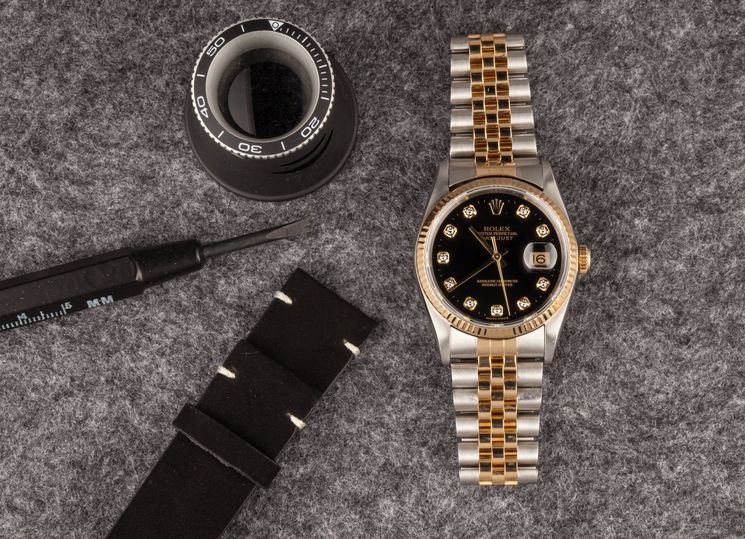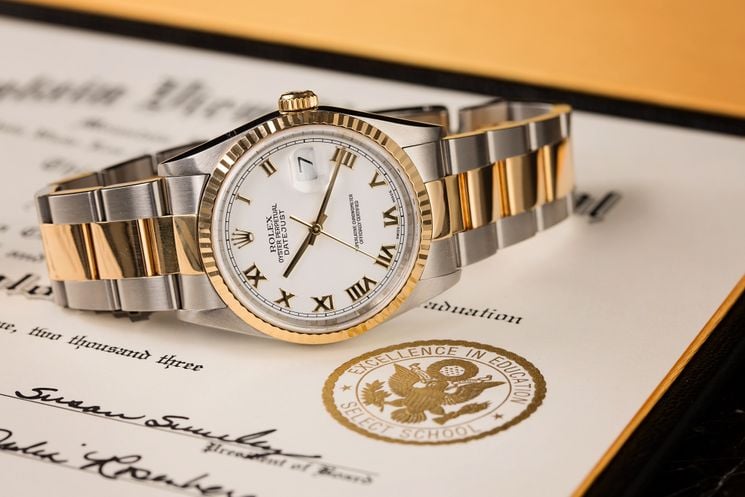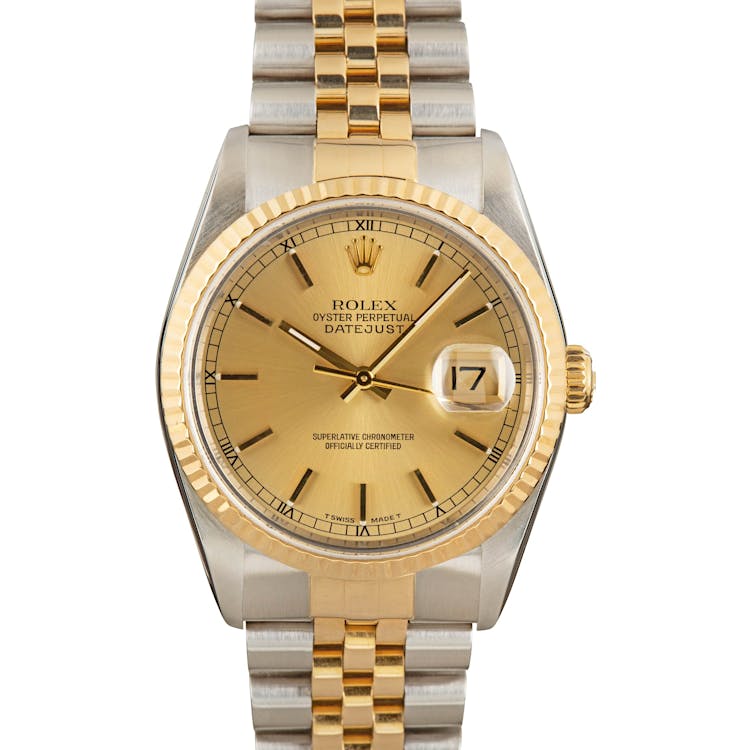Rolex 16233
Rolex Datejust Reference 16233 Features
The Rolex Datejust wristwatches is easily one of the brand's most recognizable timepieces. And, the reference 16233 is a prime example of this iconic watch, boasting a fluted bezel, a sapphire crystal, a Cyclops date magnifier and that oh-so-familiar combination of stainless steel and yellow gold.
However, besides offering incredible and timeless looks, the ref. 16233 has a rich history of modern innovations that changed the trajectory of the Rolex Datejust. Here, we're going to explore the history, significance and key features of the 16233 - one of the most important Rolex models to date.
Rolex 16233 History
 First introduced in 1988, the two-tone stainless steel and 18k yellow gold ref. 16233 was an important model in the Datejust's history, featuring some big upgrades. For one, the reference 16233 was the first Datejust to feature a sapphire crystal, replacing the acrylic crystal used for decades before.
First introduced in 1988, the two-tone stainless steel and 18k yellow gold ref. 16233 was an important model in the Datejust's history, featuring some big upgrades. For one, the reference 16233 was the first Datejust to feature a sapphire crystal, replacing the acrylic crystal used for decades before.
The ref. 16233 Datejust was also outfitted with the, at the time, brand new Caliber 3135 - the legendary workhorse that continued to power the next generation of Datejust models through 2016. The reference 16233 is also an icon among Rolex models, its two-tone case and bracelet entirely reminiscent of the trends in the 1980s and widely considered the it status symbol of the time. The iconic Rolex Datejust ref. 16233 stayed in production until 2005.
Rolex 16233 Price
The ref. 16233 is what could be considered a neo-vintage Rolex model, meaning that you cannot purchase it at a retail store or Rolex boutique. Today, the only way you can buy a 16233 is via the secondary market. The price of a Datejust 16233 is dependent on a number of different factors, including its condition and key features such as dial style, bracelet type, year of production, and overall condition.
With that in mind since all Rolex 16233 watches with be 36mm stainless steel and yellow gold models, powered by Cal. 3135 movements, and fitted with 18k yellow gold fluted bezels, the price range is not nearly as broad as it is for many other Rolex models. As of 2020, the least expensive Datejust 16233 watches cost just under $5,000, while the most expensive versions will top out at a bit over $7,000.
Rolex 16233 Key Features
The Rolex 16233 is a 36mm watch - the original and standard size of the men's Datejust. The ref. 16233 was also always outfitted in two-tone stainless steel and 18k yellow gold. Released in 1988, the two-tone Datejust 16233 was the ultimate symbol of style and sophistication, something that's come back into trend today and is again coveted among collectors. However, besides its noteworthy alloys, the reference 16233 also has a handful of other particularly iconic and special features that make it desirable.
The Dial
The dial of the reference 16233 has many variations, from champagne to white, even some exotic materials like mother of pearl. Alongside these dials you found different kinds of indices, ranging from Arabic and Roman numerals to batons, and some dils even have their surfaces engraved with various patterns, such as the desirable Pyramid and Tapestry dials.
The most common Rolex 16233 dial colors are champagne (gold), white, black, silver, and blue. However, you will also find them in other colors such as ivory and rhodium (dark silver). Additionally, there are many other colors and styles of dials such as the 'Jubilee' dials that have the 'ROLEX' name printed in an all-over pattern on the surface, and the 'vignette' dials that have a gradient effect, and 'Buckley' dials that have their Roman numerals printed, rather than being crafted from gold and applied to the surface.
Another important note about the dial of the 16233 are the three different kinds of luminescence used on its indexes and hands. Starting in 1989, the earliest examples used tritium, which is indicated on the dial by the 'T Swiss T' or 'Swiss T
Finally, the face of the ref. 16233 was outfitted with a new scratch-resistant sapphire crystal. This new material was much stronger, giving the wearer significantly increased scratch resistance, along with a more modern and refined aesthetic.
The Bezel
The bezel of the Rolex 16233 is a beautiful fluted bezel. Iconic among Rolex watches, the classic fluted bezel is a wonderful detail on the case of the watch that adds a luxurious flare to perfectly frame the dial. Rolex fluted bezels are exclusively crafted from gold, and on the reference 16233 Datejust, its fluted bezel is constructed from solid 18k yellow gold.
The Bracelet
 The Rolex Datejust 16233 was available on both a Jubilee and Oyster bracelet. Naturally, the dressier Jubilee is more historically associated with the Datejust's origins, since it was designed specifically for the Datejust and first debuted alongside the inaugural model in 1945. With that in mind, it is also a bit dressy by design and is not always the look everyone wants. So, it was very fitting that Rolex also offered the Oyster bracelet with its more traditional and simple design as an alternative for those seeking a slightly more understated look for their ref. 16233.
The Rolex Datejust 16233 was available on both a Jubilee and Oyster bracelet. Naturally, the dressier Jubilee is more historically associated with the Datejust's origins, since it was designed specifically for the Datejust and first debuted alongside the inaugural model in 1945. With that in mind, it is also a bit dressy by design and is not always the look everyone wants. So, it was very fitting that Rolex also offered the Oyster bracelet with its more traditional and simple design as an alternative for those seeking a slightly more understated look for their ref. 16233.
However, what makes the bracelet on the reference 16233 interesting is that during this time, Rolex used hollow 18k yellow gold center links, which provided further contrast in weight between this Datejust generation and subsequent editions. This design detail also not only helped keep production costs lower, but provided two key characteristics to the wearing qualities of the Rolex Datejust watches.
For both Oyster and Jubilee bracelet models, this lightness ensured that these watches weren't too hefty on the wrist and remained incredibly comfortable for the variety of collectors who loved sporting a Rolex Datejust on a daily basis. On the Jubilee bracelet in particular, this hollow design also contributed to the generally loose and almost floppy fitment of the bracelet on the wrist. Though detested by some, most wearers find this loose-worn characteristic to make this edition of the Rolex Datejust one of the most comfortable watches in existence.
The Movement
The Caliber 3135 debuted in the new Datejust ref. 16233 and was so accurate and powerful, it was used for the next 30-years by Rolex. It's the ultimate example of “if it ain't broke, don't fix it,” providing the wearer with a 48-hour power reserve thanks to a free-sprung balance with a Breguet Overcoil and improved KIF shock protection. All together, this movement's upgrades cemented Rolex's reputation of reliability and longevity. Using the Cal. 3135 in the Rolex Datejust 16233 was a hugely important upgrade that laid the foundation for the modern Cal. 3235 used today.
As a quick point of reference, the quickest way to determine whether the Datejust reference you're looking at is fitted with a Cal. 3035 - used in the generation of the Rolex Datejust that preceded the ref. 16233 - or a Cal. 3135 is by looking at its reference number. Models starting with 162xx were all equipped with the newer Caliber 3135, whereas 160xx used the earlier Caliber 3035 movement.
Rolex 16233 Timeline
Launched for the brand's 40th anniversary in 1945, today, the Datejust is considered one of Rolex's all time classics. It is also considered to be one of the most recognizable Rolex watches on the planet. With that in mind, the reference 16233 did slightly evolve throughout its production history.
- 1988 - Rolex Datejust ref. 16233 introduced
- 1995 - Reference 16233 case updated - lug holes removed
- 1998 - Tritium dials replaced with photoluminescent dials.
- 2000 - Caliber 3135 updated with Parachrom hairspring
- 2005 - Rolex Datejust ref. 16233 discontinued.
Celebrities who wear Rolex 16233 watches
If the ref. 16233 looks oddly familiar - even more than any other Rolex Datejust - it's probably because this specific reference is etched into the minds of many thanks to Hollywood. The Rolex Datejust 16233 is also known as the 'American Psycho Rolex' for its prominent feature in the classic movie, American Psycho.
In the film, Patrick Bateman (who is played by Christian Bale) wears the two-tone ref. 16233 with a beautiful tapestry dial. While the fictitious Patrick Bateman was the most famous wearer of the ref. 16233, the watch itself was incredibly prolific among the world's rich and famous over the course of its production run and still remains a popular favorite today.
FAQs
What does Rolex 16233 mean?
Rolex 16233 refers to a specific type of Role Datejust watch that has a reference number of 16233. A reference number indicates the specific model and configuration of a specific watch, and in the case of the Rolex 16233, it specifically refers to a 36mm Datejust produced between 1988 and 2004 - specifically one that will be crafted from stainless steel and 18k yellow gold, and fitted with a scratch-resistant sapphire crystal and fluted bezel.
How do you tell if a Rolex 16233 is real?
You always want to purchase a Rolex watch from a trusted, authorized dealer who can verify that it is real. However, there are certain details on the ref. 16233 that you can use to verify the authenticity of the watch. The reference 16233 only used a sapphire crystal on the dial, compared to the acrylic used on previous generations, and it is something that you will want to check. Additionally, removing the caseback of the watch will allow you to verify that it has its correct movement (all Rolex 16233 watches are fitted with the Cal. 3135).
What is the cheapest Rolex?
A Datejust is often considered one of the 'cheapest' Rolex because it is one of the most basic models in terms of features and accessibility. However, the Oyster Perpetual is actually Rolex's cheapest model with a retail price of around $5k. With that in mind, the Rolex 16233 is one of the most affordable Datejust models, especially considering that it is two-tone, meaning it boasts beautiful 18k yellow gold.
Does a Rolex 16233 scratch easily?
The Rolex 16233 is a special watch because it is a two-tone model. That means it is made up of durable stainless steel as well as elegant 18k yellow gold. Stainless steel is a sturdy alloy that stands up quite well to scratches. Gold, which is a naturally soft alloy, can be scratched more easily. However, the 18k gold alloy used by Rolex is the highest quality on the planet. Additionally, since the 18k gold is only used on the links of the bracelet, as well as on the fluted bezel, you have less opportunity to scratch up these softer surfaces.
What caliber does a Rolex 16233 use?
The Rolex Datejust 16233 uses the Caliber 3135 movement. This is one of the most prolific, powerful and reliable movements ever developed by Rolex. The Cal. 3135 features a 48-hour power reserve with and is a COSC-rated chronometer. The Caliber 3135 was used in the Rolex Datejust 16233 for its entire lifespan from 1988 to 2005, and was even used in the subsequent generation of the Rolex Datejust.
